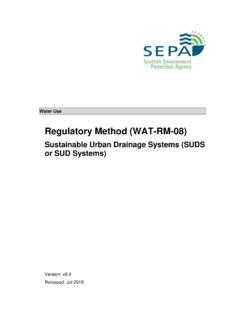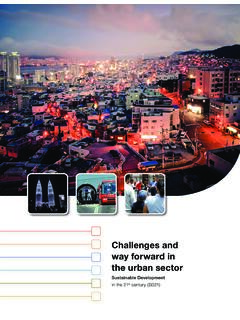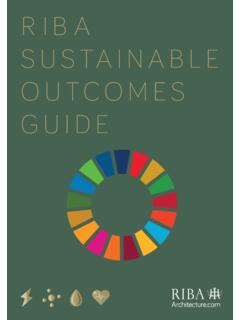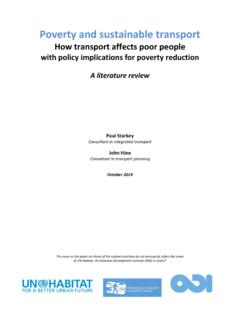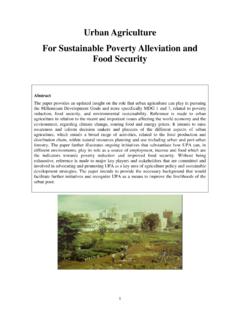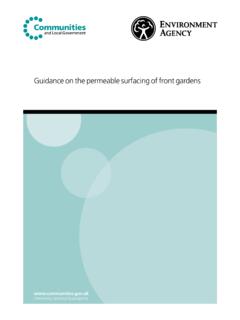Transcription of 7 Strategies for Sustainable Urban Planning - Final
1 Strategies for Sustainable Urban Planning7 Peter CalthorpePrincipal & Co-FounderThe foundation of our future rests at the intersection of environmental responsibility, social equity, and economic strength in our cities. Building community consensus is critical to successful Urban Planning , yet the effort is often fraught with challenges. Particularly in today?s political climate, the road to widespread adoption and prioritization of city sustainability is dotted with speed bumps. Urban planners are on the frontlines trying to solve these issues, yet they?ve traditionally faced an uphill battle, armed with dated tools, analytics, and disorganized data. UrbanFootprint was built to bring planners, designers, architects, developers, environmental advocates and analysts together to overcome these obstacles and support a more efficient, Sustainable Urban Planning process.
2 This white paper discusses the seven Strategies needed to help turn this vision into reality. As our global population scales to what could one day reach 10 billion people, a new vision of community, prosperity, and urbanism is long overdue. Let?s work together to help our cities survive and thrive with Sustainable design. Sincerely, To my fellow urbanists,Peter CalthorpePrincipal & Co-Founder, Calthorpe AnalyticsUrbanFootprint | 7 Strategies for Sustainable Urban PlanningThey are more and more self-adjusting, homeostatic and autonomous. In this framework UrbanFootprint changes the way cities can think about themselves. It enables self-awareness (dynamic data), articulates expectations and goals (scenarios), allows reflection (analysis of outcomes), and generates insights (patterns of co-benefits).
3 Practitioners need to steer this process with seven key Strategies for building smart, Sustainable Int ernet of Things and Big Dat a are making cit ies in many ways | 7 Strategies for Sustainable Urban PlanningM ak e Co n n ec t i o n sCo n n ec t d a t a , p eo p l e, a s p i ra t i o n s , n eed s , o p p o r t u n i t i es , f u t u res , a n d o u t c o m es .1 UrbanFootprint | 7 Strategies for Sustainable Urban PlanningCreating connections is fundamentally what cities do, and it is what designers must do if they are to succeed. Great cities create connections between people of all ages, incomes, and races. They enhance connections to the natural environment, to history, to local culture, and to goods and services. They are also places that connect ideas, that cross-fertilize, that foster innovation and mix the foreign with the local, the regional with the neighborhood.
4 They are the armature of the global world. More and more the act of creating an Urban design, a plan, framing the right infrastructure or public policy, involves enhancing connections. These connections are most typically between stakeholders and special interests that too often see their goals as isolated, view outcomes as winner-take-all, and understand plans as fixed. In addition, we need connections between isolated and growing data sets, stovepipe professional analysis, and facts that too often evade the discussion. Connecting information in ways that create insight is fundamental to understanding and enhances the ability to realize this range of connections; between people, between people and place, between sets of information, and between solutions that reinforce each other.
5 More and more the act of creating an Urban design, a plan, framing the right infrastructure or public policy, involves enhancing connections. UrbanFootprint | 7 Strategies for Sustainable Urban PlanningCo l l ag e Dat aIn t eg ra t e d a t a t o rev ea l p a t t ern s , ed u c a t e s t a k eh o l d ers , a n d ex t en d b o u n d a ri es .2 UrbanFootprint | 7 Strategies for Sustainable Urban PlanningWe are swimming in data and it is growing at phenomenal challenge is to translate this onslaught into useful information. We are swimming in data and it is growing at phenomenal challenge is to translate this onslaught into useful information. This involves synthesizing what are now isolated streams and distilling the data into useful information.
6 And this information must be translated into insight and insights must be shared. Digesting data is an interactive practice that involves much more than downloading bits. It involves layering data in ways that reveal new connections, synergies and causalities ? effectively revealing deeper patterns born of isolated data sets. It involves the ability to edit and layer diverse and complex information in ways that enhance understanding a place and setting directions for the future. It also involves asking the right questions easily in ways that integrates many dimensions of input. Just as a collage brings a larger order into focus from fractured pieces, UrbanFootprint allows Urban designers to combine, query, and connect data in ways that creates insight and supports solutions.
7 UrbanFootprint | 7 Strategies for Sustainable Urban PlanningS o l v e f o r t h e Fu t u r eDes i g n f o r m u l t i p l e f u t u res ra t h er t h a n p er f ec t i n g t h e p res en t .3 UrbanFootprint | 7 Strategies for Sustainable Urban PlanningMuch Smart Cities efforts are rightly focused on improving how we, piece by piece, make existing systems more efficient. Software and technology that makes better use of our buildings, roads, services, and open space is critical to setting the stage for a more inclusive and less demanding city. But also needed are tools and practices that shape a more coherent long-range future, that look to the large changes in context and infrastructure that incremental fixes tend to miss. Future land-use patterns and circulation systems are the foundation of better cities, shaping the next generation of investments, systems and policies.
8 We cannot understand the efficacy of new Strategies and infrastructure without setting them in a future framework. UrbanFootprint studies different Urban futures, tests new policies, and understands their impacts over time. Resilience, climate change, affordability, and economic growth are dependent on the right combinations of Urban form, technology, economic investments, and social norms. What is viable today will be obsolete tomorrow if we do not solve for the future. We cannot understand the efficacy of new Strategies and infrastructure without setting them in a future | 7 Strategies for Sustainable Urban PlanningB u i l d S c en ar i o sTes t v a ri ed s t ra t eg i es , p res s ex t rem es , a n d f i n d t h e s w eet s p o t .4 UrbanFootprint | 7 Strategies for Sustainable Urban PlanningScenario Planning assumes that we cannot predict the future because of unforeseen events and multiple forces.
9 Scenario Planning has been used by the private sector and the military for decades for strategic Planning based on a range of assumptions. Scenario Planning assumes that we cannot predict the future because of unforeseen events and multiple forces. Instead it is a methodology that learns by testing different futures from a matrix of probable primary drivers. It brackets the future and reveals Strategies that can adapt to differing futures or work with the largest range of outcomes. But there is another reason for building Urban scenarios ? to be inclusive of and to test differing preferences of participants. Each stakeholder and special interest group brings their own ideal future born of their own priorities. These special interest scenarios tend to be shaped around one preferred outcome rather than multiple advantages.
10 Scenario Planning allows all to see their idea affirmed as a potential future, analyzed across differing metrics, and then rationally compared to others. In so doing, scenario Planning often reveals co-benefits and new coalitions between historically isolated interests. This is a catalyst for political change that in turn is the foundation of real change. UrbanFootprint allows planners to build scenarios and run analysis quickly so that sensitivity studies or public preconceptions can be clarified in real time. It also reveals the potential co-benefits that can enhance new coalitions and political initiatives. UrbanFootprint | 7 Strategies for Sustainable Urban PlanningS eek Co - B en ef i t sTra n s f o rm s i n g l e-i s s u e a d v o c a t es i n t o c o a l i t i o n s , rev ea l i n t erc o n n ec t ed o u t c o m es.
